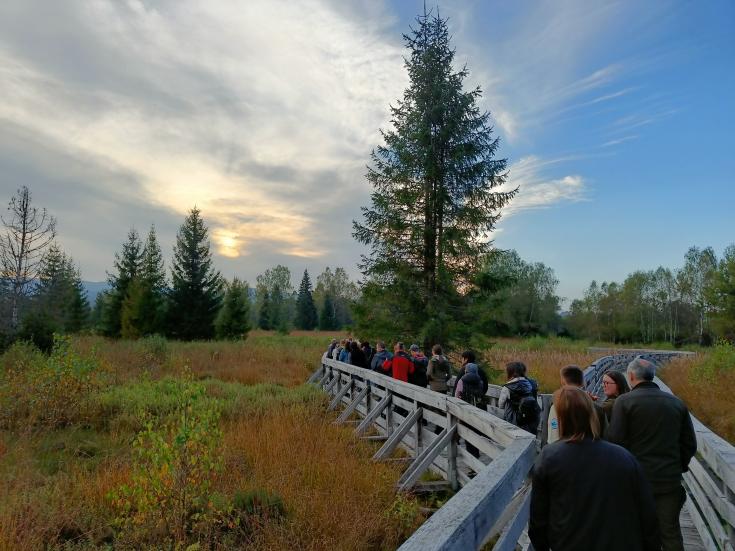3rd Inter-regional Learning Event - Podkarpackie, Poland
On 17-18 September 2024, GREENHEALTH project partners met in Podkarpackie for the 3rd interregional event, focusing on sustainable inclusivity. The Voivodeship was represented by Ms Anna Huk - Voivodeship Board Member and Ms Ewa Draus - Voivodeship Assembly Councillor.
The visit started in Rzeszów, where participants traveled to Krosno to the Faculty of Herbal Studies at the National Academy of Applied Sciences.The next stop was the Forestry Promotion Centre in Muczne, which hosted the workshop discussions.
Ms Anna Huk opened the event. She explained that the Bieszczady Mountains were selected for the workshop due to their unspoiled landscape and attracting nature enthusiasts globally. She then introduced the Podkarpackie 2030 Strategy development, aiming at enhancing the economy, fostering human and social capital, protecting the environment, and improving infrastructure to elevate residents' quality of life. The Strategy includes a Programme for the Bieszczady mountains. The GREENHEALTH project avails ecological solutions to enhance well-being as its main goal is to integrate environmental protection with health promotion, collaborating with local and international partners to create a sustainable ecosystem for current and future generations.
Ewa Tkacz, the Forest District Manager, welcomed the workshop participants on behalf of the Stuposiany Forest District, highlighting the area's rich natural qualities, which need protection.
The first speaker, Ms. Grażyna Holly, Deputy Director of Bieszczady National Park, introduced the park's natural, cultural, social, and educational values, focusing on visitors’ accessibility.
The Good Practice exchange session started through elevator pitches from all partners, who shared their inspiring work about inclusive paths and trails, adapted to different people’s requirements, including wheelchair users or visually impaired persons. We also spoke about how persons at risk of social exclusion can benefit from nature connection, increase their health, well-being & their environment protection behaviours.
Dariusz Kozik, Acting Director of the Landscape Parks Complex in Przemyśl, presented the first good practice from Poland, which consisted of a sensory garden in the Arboretum of Bolestraszyce.
After the presentation we could visit Tarnawa Wyżna peat bog. The latter is the largest Bieszczady floristic and peat bog reserve and features rare plant species like round-leaved sundew, bog cranberry, and hosts various butterflies, dragonflies, and beetles. It provides refuge for birds such as corncrakes and woodcocks, as well as reptiles and amphibians. Here, visitors can also enjoy stunning panoramic views of the Bieszczady Mountains.
After recharging our energy through the insightful visit to the peat bog restoration project in Tarnawa Wyżna, we concluded our learning session with a Q&A & discussions in groups.
A networking dinner at the Forestry Promotion Centre in Muczne closed the day.
The second day began early with a hike up Bukowy Brod mountain for a sunrise view, for willing participants.
In the morning project partners attended the GREENHEALTH Steering Committee, while other guests visited an exhibition at the Forestry Promotion Centre in Muczne. A pavilion, developed by the Stuposiany Forestry Commission, features seven thematic sections showcasing various plant and animal species in their natural environments.
On the 2nd day our study visit primarily focused on a 4,5 km hiking trail with audio description with the TOTUPOINT system and other facilities for the blind and visually impaired - leading from Muczne to the 34-metre-high observation tower on top of Jeleniowaty - Deer Peak. This system consists of an innovative solution to aid spatial orientation and increase safety for people with visual impairments. It includes a mobile application on the user's phone, connecting via bluetooth to so-called ‘markers’ - devices that, by emitting sound, inform the user of their location with a text or voice message. The trail leads from Muczne, all the way to the observation tower.
Later, we visited the European bison demonstration enclosure in the Muczne forestry. This facility focuses on nature education and is a major tourist attraction in the region. Since 2012 the enclosure, has aimed to enhance the genetic condition of the Bieszczady bison.
On the return to Rzeszów, we visited the Greek Catholic Church of St. Michael the Archangel in Smolnik - a UNESCO World Heritage Site.
The 3rd interregional event served as both a scientific workshop and a platform for participant integration, emphasizing the importance of international cooperation and collaborative actions for environmental protection and human well-being.
This article is an adaptation of the one published by our host, Podkarpackie Region. You can read the original piece at this link.


